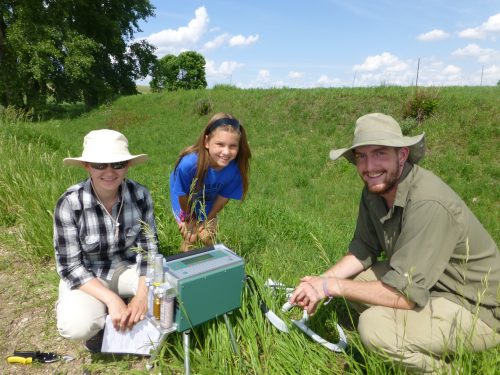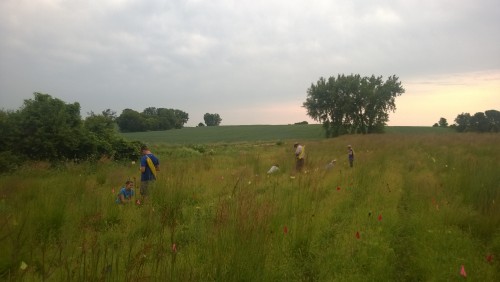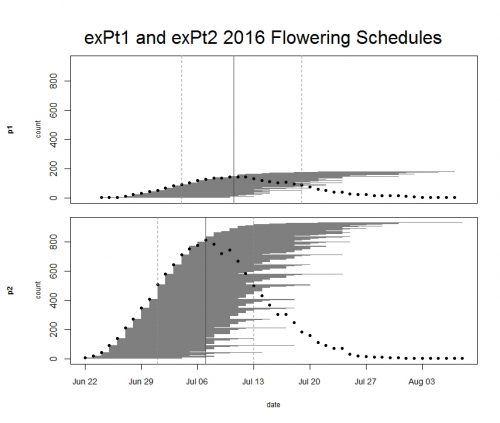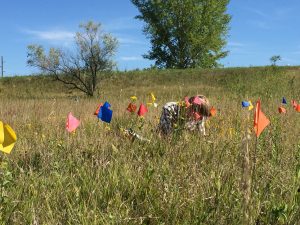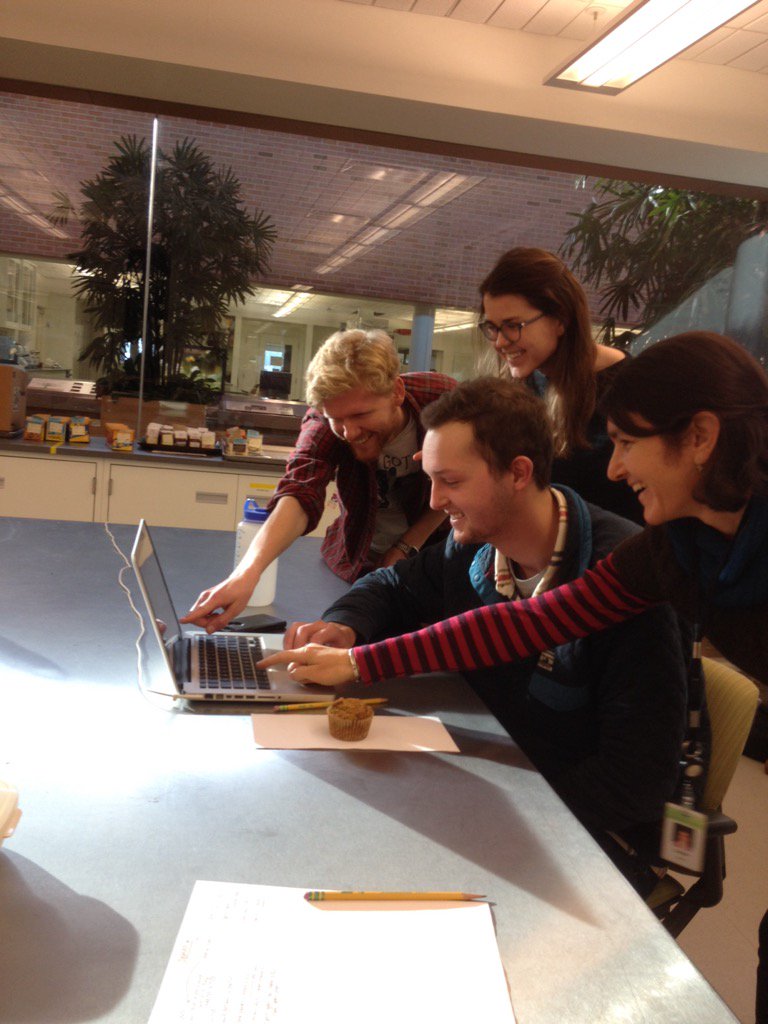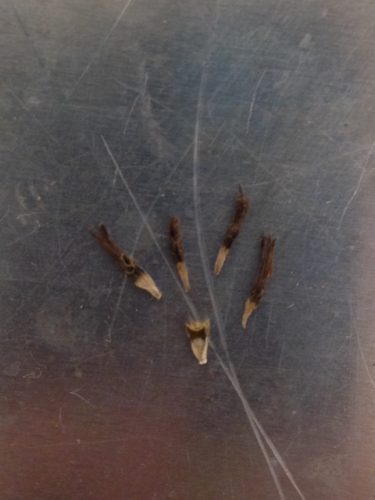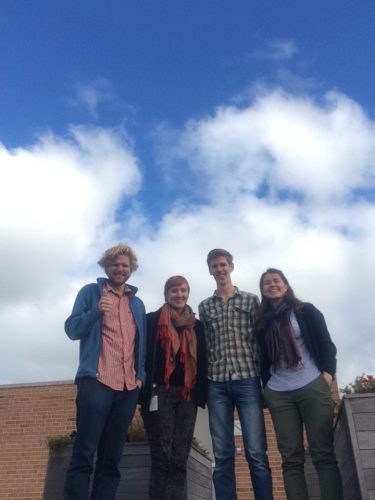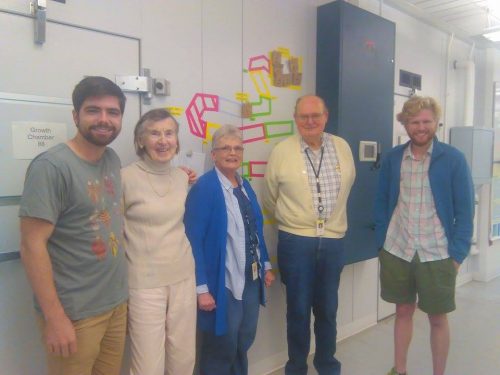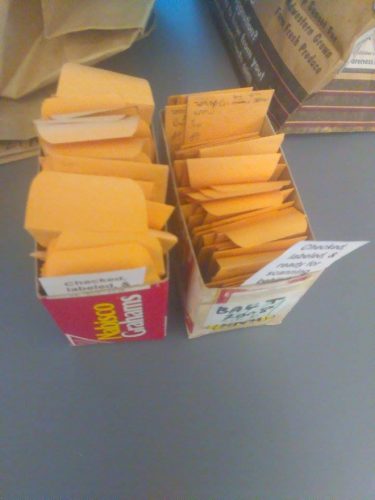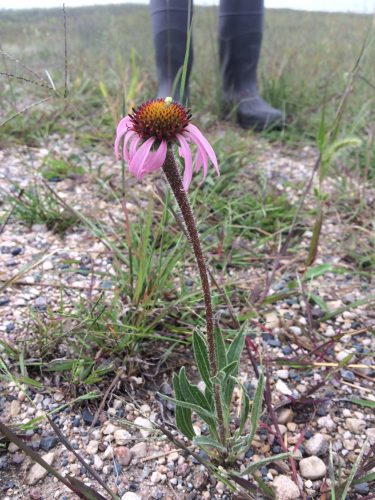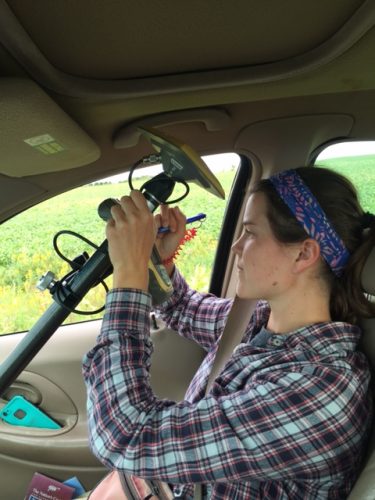|
|
 Reina, Hattie, and Mike with the instrument to measure photosynthesis. In 2016, we continued the INB1 experiment to investigate the relationship between inbreeding level and fitness in Echinacea angustifolia. Each plant in experiment INB1 originates from one of three cross types, depending on the relatedness of the parents: between maternal half siblings; between plants from the same remnant, but not sharing a maternal or paternal parent; and between individuals from different remnants. We continued to measure fitness and flowering phenology in these plants.
This year, of the original 557 plants in INB1, 191 were still alive. Of the plants that were alive this year, 7% were flowering and 24% have never flowered.
Read previous posts about this experiment.
Start year: 2001
Location: Experimental plot 1
Overlaps with: Phenology and fitness in P1
Physical specimens: We harvested 13 heads from INB1 that will be processed in the lab with other heads harvested from P1.
Data collected: We used handheld computers to collect fitness data on all plants in INB1.
Products: The below papers were published in summer 2015:
Kittelson, P., S. Wagenius, R. Nielsen, S. Qazi, M. Howe, G. Kiefer, and R. G. Shaw. 2015. Leaf functional traits, herbivory, and genetic diversity in Echinacea: Implications for fragmented populations. Ecology 96:1877–1886. PDF
Shaw, R. G., S. Wagenius and C. J. Geyer. 2015. The susceptibility of Echinacea angustifolia to a specialist aphid: eco-evolutionary perspective on genotypic variation and demographic consequences. Journal of Ecology 103:809-818. PDF
You can find more information about the Inbreeding experiment–INB1 and links to previous flog posts regarding this experiment at the background page for the experiment.
 Team Echinacea measuring plants in big batch The qGen1 (quantitative genetics) experiment is designed to quantify the heritability of traits in Echinacea angustifolia. We are especially interested in Darwinian fitness. Could fitness be heritable? During the summer of 2002 we crossed plants from the 1996 & 1997 cohorts of exPt1. We harvested heads, dissected achenes, and germinated seeds over the winter. In the Spring of 2003 we planted the resulting 4468 seedlings (this great number gave rise to this experiment’s nickname “big batch”). In 2016 we assessed survival and fitness measures of the qGen1 plants. 2,187 plants in qGen1 were alive in 2016. Of those, 5% flowered in 2016 and 49% have yet to flower.
Start year: 2003
Location: Experimental plot 1
Overlaps with: qGen2 & qGen3
Physical specimens: We harvested 116 heads from qGen1 in 2016. These heads will be processed in the lab to determine achene count and seed set.
Data collected: We collected fitness measures using handheld computers.
Products: We have an awesome dataset that we will share once the paper is published. Ruth Shaw is working on an analysis of the qGen1 dataset.
You can find more information about Heritability of fitness–qGen1 and links to previous flog posts regarding this experiment at the background page for the experiment.
Every year we keep track of flowering phenology in our main experimental plots, exPt1 and exPt2. Fewer plants than usual flowered in exPt1 in 2016: 149 plants (179 heads) flowered between June 24th and August 7th. The population’s mean start date of flowering was July 5th and the mean end date was July 18th. Peak flowering in 2016 was on July 10th, when 143 heads were in flower. For comparison, peak flowering in 2015 was on July 27th, when there were nearly 10x as many heads flowering as on this year’s peak. The earlier phenology and low numbers of flowering we observed this year relative to 2015 is likely due at least in part to the plot burn schedule (2015 was a burn year and 2016 was a non-burn year), but there were still many fewer flowering plants than any season, burn or non-burn, in the past 10 years.
We kept track of 934 flowering heads in ExPt2, where the first head started shedding pollen on June 22 and the latest bloomer ended flowering on August 8th. Peak flowering was on July 7th, when 810 heads were flowering. ExPt2 was designed to study the heritability of phenology—you can read more about progress of that experiment in the upcoming 2016 heritability of phenology project status update.
At the end of the season we harvested the heads and brought them back to the lab, where we will count fruits (achenes) and assess seed set.
 ExPt1 and Expt2 flowering schedules from 2016. Dots represent the number of flowering heads on each date. Horizontal line segments represent the duration of each heads flowering and are ordered by start date. The solid vertical line indicates peak flowering, while the dashed lines indicate the dates when 25% and 75% of heads had begun flowering, respectively. Click to enlarge! Start year: 2005
Location: Experimental Plots 1 and 2
Overlaps with: Heritability of flowering time, common garden experiment, phenology in the remnants
Physical specimens: We harvested 177 heads from exPt1 and 870 from exPt2. Attentive readers may note that we harvested about 64 fewer heads than we tracked for phenology. That’s because before we could harvest many seedheads at exPt2, rodents chewed through their stems and ate some fruits (achenes). We recovered most of the heads that were grazed from the ground and made estimates of number of fruits lost due to herbivory, but we couldn’t find some heads. Arg. We brought the harvest back to the lab, where we will count fruits and assess seed set.
Data collected: We visit all plants with flowering heads every three days until they are done flowering to record start and end dates of flowering for all heads. We managed phenology data in R and added it to the full dataset. The figure above was generated using package mateable in R. If you want to make figures like this one, download package mateable from CRAN!
You can find more information about phenology in experimental plots and links to previous flog posts regarding this experiment at the background page for the experiment.
 We revisited locations in remnants where flowering plants were observed in previous years. We tag each Echinacea plant we see flowering in our prairie remnants, and record its location using the GPS. This is useful because it allows us to revisit the same plant in future years, checking to see if it is still alive, and if so how large it is and whether or not it is flowering. This has provided us with a very rich longitudinal dataset of life histories, dating back two decades and including thousands of plants. This year, we did total demo, visiting each plant in our database, at several sites including Staffanson, Loeffler’s Corner East, Northwest of Landfill, and East Elk Lake Road. In the interest of time, we only did flowering demo (only visiting plants that flowered this year) at several sites, including Landfill, Around Landfill, and Railroad Crossing. For each plant visited, we recorded its status (e.g., basal, flowering), its number of rosettes, and any neighboring Echinacea within a 12 cm radius. This data can be used to study inter-annual variation in flowering, population dynamics, and response to fire.
Year: 1996
Location: Roadsides, railroad rights of way, and nature preserves in and near Solem Township, Minnesota.
Overlaps with: Flowering phenology in remnants, fire and flowering at SPP
Data collected: Flowering status, number of rosettes, number of heads, neighbors within a 12 cm radius of plants found, stored in demo2016
GPS points shot: Points for each flowering plant this year shot mostly in PHEN records, stored in surv.csv. Some points of flowering plants stored in SURV records, also in surv.csv. Each location should be either associated with a loc from prior years or a point shot this year.
Products:
- Amy Dykstra’s dissertation included matrix projection modeling using demographic data
- Project “demap” merges phenological, spatial and demographic data for remnant plants
You can find out more about the demographic census in the remnants and links to previous posts regarding it on the background page for this experiment.
Hi Flog! It’s me, Amy!
This winter we’ve been working on ‘demap’, a project to coordinate 20+ years of demography and spatial data from remnant populations of Echinacea in Solem Township. When we are done we will have a great long-term dataset of over 3000 individuals in 27 remnant populations. We can use that information to answer all kinds of questions about flowering dynamics in natural populations, population growth, and the consequences of disturbances such as habitat fragmentation and fire! In particular, this January we focused our efforts on answering questions about the demographic consequences of fire. Does fire’s stimulation of flowering contribute to increased population growth over the long term? Do reproductive benefits of fire outweigh potential survival costs? We’re not sure, but we hope to find out by analyzing four populations– a large population that had one fire event, a large population that has not been burned in the past 20 years, a small population that burned once, and a small population that has not burned in the past 20 years. We’ll combine our demography data about flowering and survival with other information, such as the seedling recruitment and remnant seed set data, to project population growth.
Will was here to help out with the project in the first two weeks of January. We got a lot done with demap and made meaningful progress on other big questions such as “Is kale overrated?” and “What does overrated mean statistically?”. We also made big strides in terms of professional development by studying business mogul DJ Khaled’s keys to success. Stay tuned for updates!
Sincerely,
Amy
 Demap is a team effort! In this shot, we are helping Will find a plant on the computer.
So it begins! Two new externs have joined Team Echinacea from Carleton College. We (Mikaela and Emma) will be here every day for the next three weeks, and are excited to discover new revelations for the Asynchrony, Isolation and Incompatibility experiment.
So far, most of what we’ve discovered is that cleaning Echinacea seed heads is tedious. Two days in, we have cleaned 36 seed heads; scanning them was a nice relief from the monotony. We think we could get through all 110 by the end of this week.
Although yesterday was quiet, there was a little bit of commotion: Mikaela’s second seed head had a rare deformity. Many of the achenes were uninformative. This means they were aborted part of the way through formation, so it cannot be determined whether they were fertilized. After minutes of puzzled deliberation, Stuart, Amy and Scott decided to keep them in the sample.
 Four uninformative achenes compared to one normal, small-to-mid-size achene. Because of their immaturity, the florets are still firmly attached. In contrast to yesterday, today there were quite a few volunteers and a couple of students who we got to meet. It was nice to talk to other people who were involved in and excited about this project. We also got to hear about other experiments going on in the lab besides our own.
Today’s seed cleaning also presented an exciting moment: just moments after Amy told us about last year’s larval discoveries, we each found a live larva residing in the heads we were cleaning. We’re thinking about raising these mystery larva so we can finally learn just what they are. Hopefully we’ll have more success than last year’s effort!
 Our two larva. Emma’s is the tiny brown one on the right, and Mikaela’s is the pink one hanging out on a makeshift habitat of chaff. We are grateful for this opportunity to contribute to and learn from the project, and are looking forward to the next three weeks!
Thanks for the warm welcome,
Mikaela and Emma
Dear Flog,
Last time I mentioned in passing that Stuart, Amy, Scott, and I had been discussing papers about fire and its potential impact on the reproductive fitness on Echinacea plants. This week I will go into greater detail about what I’ve learned about fire and what our data can teach us about how it impacts prairie health.
Some of our studies taken from previous years have shown us that, even when there are enough bees to carry pollen from plant to plant, Echinacea plants can have difficulties receiving pollen from potential mates. There are a few reasons for this. In our fragmented prairie remnants, Echinacea plants are often far enough apart that pollen collected by a bee will often fall off before it can reach another Echinacea flower. Echinacea plants may also flower in different years, or at different times in the season. This can prevent mating even between close flowers. This mate availability problem is compounded by the fact that Echinacea is self-incompatible, meaning a plant cannot pollinate itself or its close relatives. This means that if a plant flowers and fails to find mates, all the energy it expends to flower and fruit results in no offspring. This is an extraordinary energy cost for no payoff.
Data we have collected seems to suggest that fires may help perennial prairie plants like Echinacea find other mates. Explosive flowering after a large burn is typical for prairie plants. There is some evidence that increased availability of nutrients from burned organic matter and the increased availability of sunlight provide resources for a plant to invest in a costly reproductive structure like a flower. This is probably no different for Echinacea. However, as an added bonus, some of our data seems to show that this explosive flowering may reduce the reproductive isolation of Echinacea plants by increasing the number of synchronous flowering plants. Thus, fire helps Echinacea successfully seed by increasing the number of available mates. Really cool!
The tendency of Echinacea to flower synchronously after a fire could be the result of natural selection, or simply a byproduct of the excellent growing conditions created by fire. In either case, this knowledge affirms how important fires are to prairie ecosystems. The Echinacea Project, through projects like SppBonus, hopes to further elucidate these mechanisms through which fire improves prairie health.
Until next time!
Sam
Citations:
Wagenius, S. and Lyon, S. P. (2010), Reproduction of Echinacea angustifolia in fragmented prairie is pollen-limited but not pollinator-limited. Ecology, 91: 733–742. doi:10.1890/08-1375.1
https://echinaceaproject.org/pub/wageniusAndLyon2010.pdf
Ison, J.L., S. Wagenius, D. Reitz., M.V. Ashley. 2014. Mating between Echinacea angustifolia (Asteraceae) individuals increases with their flowering synchrony and spatial proximity. American Journal of Botany 101: 180-189.
https://echinaceaproject.org/pub/isonEtAl2014.pdf
Part 1. I couldn’t stay away from the Echinacea Project too long. As I’m positive you want to hear both about my poster that I will be presenting at MCMS tomorrow at the University of Chicago and my adventures in Chicago, I will share both. As I arrived at the airport to fly to Chicago, I realized I had forgotten my cell phone. I thought to myself, I lived most of my life without a cell phone, I can do it another day. After arriving in Chicago, I had thankfully packed a dollar in quarters, so I was able to use a pay phone (yes, those still exist) to call a cab. While I did struggle to understand the technology, I was finally able, after spending my only dollar in quarters, to procure transportation to the Chicago Botanic Gardens. I was left penniless, phoneless, and with only a laptop and my knowledge of Chicago (this, by the way, was absolutely nil). After making a successful rendezvous with the team, I enjoyed a lunch and tour of the lab. It was great to see everyone again.
Part 2. After figuring out the best way to get to my destination at the University of Chicago, I jumped on the purple line, confident that, after a quick jaunt on the green line, all I’d have to do was walk a block or two to the hotel, where dinner awaited me. I hopped off the train, and quickly realized that the area had been highly developed since the last google street image had been taken, unless my memory of the picture failed me. Ah well, I thought, I wrote down the street that will get me to my hotel, it’s just east of here. The street just east was not the correct street. Maybe the map I saw was just wrong. By the next street, I knew I was in the wrong place. Thankfully a friendly man suggested a bus that would take me five miles to the east, where I thought I was getting off. Yes, I had taken the wrong train. All was well and good until I hopped on the bus and realized that I was penniless, with no money for a fare. Again, the bus driver was a greatly friendly man, and I rode the bus without a fare. Sailing was smooth from there on out.
Tomorrow I will present my findings on how edge effects play a role in the style persistence and pollen limitation of Echinacea at the Midstates Consortium for Math and Science. Style persistence decreased as plants were farther from habitat edges, demonstrating a spatial pattern in pollination. Attached is my poster. stylepersistenceedgeposter
Off to share a room with someone I haven’t met yet. Day in the life.
 No explanation needed. Great to see y’all again.
Hey Flog!
My name is Sam Hamilton, and I am a Northwestern senior doing research in the Echinacea Project lab this quarter. My project specifically seeks to understand the relationship between prairie fires and reproductive success of flowering plants using our model organism A. Echinacea. This is an important relationship to understand because, while historically fires were an integral part of the prairie life cycle, today’s isolated prairie remnants are often never burned. This could have a large impact on the success of shorter plants that rely on the extra sunlight and nutrients that a burn year supplies to flower and germinate. This quarter, I will be collecting the data from seed heads collected this year and analyzing it along with data collected in previous years to draw my conclusions.
I am also looking at the reproductive success of Echinacea flowers collected from the bottom, middle, and top of each head. In Echinacea, flowers mature first at the bottom and slowly develop towards the top over time. This allows us us to deduce when a plant was pollinated best during the season. I’ve been hard at work the past month cleaning seed heads and separating their achenes into top, middle, and bottom sections for later analysis. It’s been a lot of work, but the great company has kept it fun!
Until next time!
-Sam

Myself with Susie, Char, Aldo, and Scott. (Left to Right)

One month of cleaned and organized achenes.
After a slow start, Amy and I did demography at some of the recruitment plots near Hegg Lake and p2. The flowers in plots HE and HS, near P2, were doing especially well; we counted a total of 34 flowering plants combined in those two plots, with several having multiple heads, and were able to find nearly all of the plants there. We also returned to a stand of Cirsium hillii near p2 that we measure each year, and found that at least three of our study plants flowered recently. Whether they flowered this year or last year is not yet clear — the leaves definitely looked gray and crispy. Stuart made the long trek back from Chicago today and harvested some Astragalus canadensis for broadcasting and corralled an escaped goat.
The highlight of today was finding a flowering (second day!) Echinacea near the Cirsium study area. We finished phenology in all of the remnants and plots several weeks ago, and have even harvested a good number of heads that are ready to drop their achenes. How this one is flowering so late in the season is a mystery — it may have to do with some recent mowing. We look forward to revisiting this plant to see if, by some miracles, it gets lucky and some of its styles shrivel.
 Flowering (second day!) Echinacea found today near P2. Outrageous!  Amy and Chek look for Echinacea from the car.
|
|
